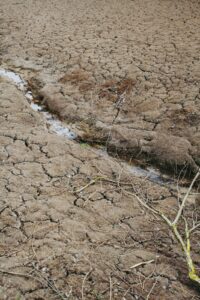Higher rates, watering restrictions could be on tap soon


Every week, the news is more dire: The City’s overall water supply level continues to decline due to drought conditions in Southeast Kansas, where the watershed for the City’s primary water supply source, Hulah Lake, is located.
The City launched a public awareness campaign in December of last year in hopes of increasing conservation efforts. At the time, the water supply level was at 71 percent.
Today, it’s 63.6 percent.
“We would consider the ‘critical’ point to be 50 percent or below,” said Water Utilities Director Terry Lauritsen. “At that point, we would need to have implemented pretty drastic restrictions in order to make the water that is left last as long as possible.”
What’s being done?
In fact, some restrictions aimed at water use reduction could be implemented as soon as next month, if approved by the City Council during its April meeting.
“The City Council is expected to consider modifications to the Water Storage Ordinance and a resolution to enact the emergency water rate provisions of the Water Shortage Ordinance,” Lauritsen said. “The ordinance modifications will better define and update measures outlined in the Drought Contingency Plan, which was written following the drought of 2002.”
In accordance with the plan, upcoming restrictions for the public are likely to include a combination of measures aimed at reducing consumption. Proposed measures include:
- Higher water rates
- Restrictions on outdoor watering
- Splash pad closures
Bartlesville is currently in Phase 2 of the Drought Contingency Plan, based on water supply falling between 70 and 60 percent. Some measures already implemented include the City discontinuing water use for its fleet (with the exception of sanitation vehicles) and non-essential operational uses, altering watering of parks and golf courses, notification to wholesale customers, and public education.
If these measures fail and supply continues to decline to extreme levels, pushing the area into Phase 3 of the plan, rates could go even higher, outdoor watering could eventually be eliminated altogether, and City-owned swimming pools could be closed this summer.
“The best thing that could happen, of course, is for it to rain in Southeast Kansas,” Lauritsen said. “Additionally, we anticipate having the Caney River Pump Station back on-line by mid-April, so that could have an impact or at least slow the rate of decline.” (The pump station was taken off-line in mid-2021 for a much-needed renovation. Supply chain issues have kept it closed far longer than anticipated.)
June: Projected critical point
While the pump station getting back on-line is welcome news, it comes just as water use for the area is expected to increase going into the summer. Water use is currently at 4.14 million gallons per day (mgd), which is about typical for this time of year, Lauritsen said.
“Unfortunately, that number typically goes a lot higher as we move into the hotter, drier months,” he said. “We can spike up to 11 and 12 mgd during the hottest times of the year.”
If rain is the best-case scenario, what is the worst?
“If it doesn’t rain, and if our water use climbs as it would during a typical summer, we anticipate dropping below 50 percent of water supply sometime in June,” Lauritsen said.
“It is imperative that we all do what we can to save water now.”
Here’s how you can help:
- Take shorter showers. This is the No. 1 most effective thing we can do, indoors, to conserve.
- Consider installing “low flow” plumbing, i.e., toilets, shower heads, etc. Also, replace any leaky or defective parts.
- Turn off the tap while brushing your teeth or shaving.
- Never use the toilet as a wastebasket. Only human waste and toilet paper should go into the toilet — ever.
- Run the washing machine only when full and adjust the water level setting carefully.
- Stop or reduce outdoor watering.
For more information, see www.cityofbartlesville.org.
